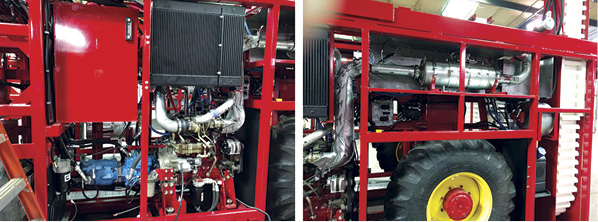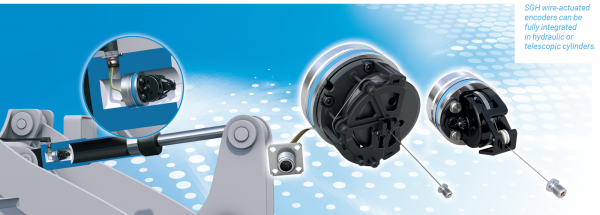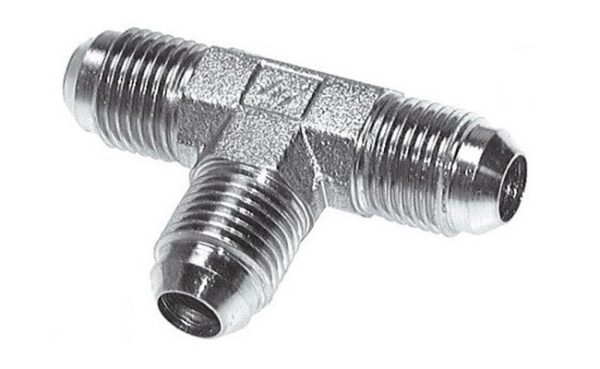Mobile Equipment Reservoir Baffle Innovation
Hydraulic oil in mobile equipment reservoirs has disturbances caused by the motion of the equipment. Fluid disturbances are commonly called “sloshing” and cause a number of issues, such as breather damage, short-circuiting, diffusion, and entrainment. In this article, sloshing is illustrated, along with a solution.
Rapid vehicle deceleration frequently occurs in forklifts and pick-up truck-mounted snowplows. During rapid deceleration, sloshing fluid can saturate the reservoir breather. When sloshing fluid covers the breather, air cannot escape as fast as the fluid entering the reservoir. The resulting pressure rise damages the breather, allowing fluid to spill out of the reservoir. Forklift operators can also subject equipment to rapid acceleration.
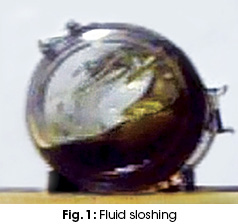 Fig. 1 illustrates the behavior of a fluid in a cylindrical reservoir when subjected to a rapid change in velocity.
Fig. 1 illustrates the behavior of a fluid in a cylindrical reservoir when subjected to a rapid change in velocity.
Conventional designs have a reservoir breather installed at the top of the reservoir. If a reservoir breather was installed in the reservoir during these simulations, the internal surfaces of the breather would be wetted by the fluid.
Damaged breathers can cause catastrophic system failures and create environmental issues due to fluid loss. Laboratory tests show that a breather element, which is merely saturated with fluid, will allow air to escape with low-pressure drop. The problem begins when attempting to push fluid through the breather.
Under normal operating conditions, fluid returning to a reservoir pushes air out of the reservoir through the breather. However, during sloshing, the fluid covering the breather opening is forced into the breather. Far greater pressures are required to push fluid through a breather filter element designed for air passage.
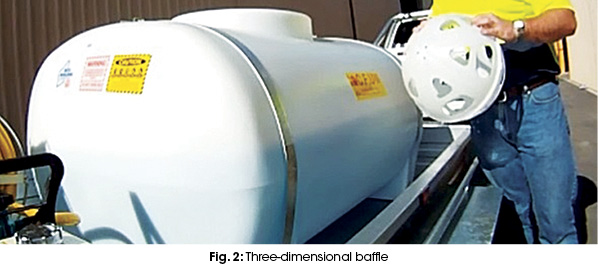
Three-dimensional baffles, as shown in Fig. 2, are effective at controlling fluid motion in all directions. Three-dimensional fluid agitation requires a three-dimensional solution. Scaling down rigid 3D baffles from tanker trucks to reservoirs smaller than one gallon requires another solution. Decreasing the size of discrete rigid 3D baffle elements is not a practical solution. Small discrete baffle elements interfere with assembly of the mobile equipment reservoirs with internal components, such as pumps, valves, and suction ports.
Compliant open-cell foam provides the structure necessary for three-dimensional dynamic fluid damping without adding assembly complexity. A custom three-dimensional shape can be made at a relatively low cost, often less than $1 for four-liter (one-gallon) reservoirs.
Caution should be exercised when selecting foam for this application. Open-cell foam is manufactured two very different ways, and one method is highly preferred over the other. Reticulated foam manufactured using the quench method can leave powdery deposits from the caustic solutions used to remove membranes between the pores. Reticulated foams manufactured with the zapping method are cleaner and smoother. With the zapping method, an explosive gas wave front propagates through the foam, melting pore membranes and smoothing contact surfaces. The explosive gas melts loose ends together and does not leave a residue.
Polyester open-cell foam has good resistance to chemical attack from hydraulic fluid and phosphate ester fluids, such as Skydrol. However, it is recommended that users collaborate with foam providers on specific applications for temperature and chemical compatibilities.
To observe how little fluid is displaced by the foam in the reservoir, simply compress the foam to a solid.
Increasing the number of pores per inch (PPI) in the foam will increase fluid stability, but may create an issue for suction lines. Increasing gaps with lower PPI allows fluid to pass more freely.
Increasing PPI decreases the size of the pores. Decreasing pore size decreases the size of the openings in the foam, which reduces fluid passage cross-sectional area, resulting in increased pressure drop. Only open-cell foams with a pore density less than 20 PPI are suitable for mobile equipment hydraulic fluid reservoirs.
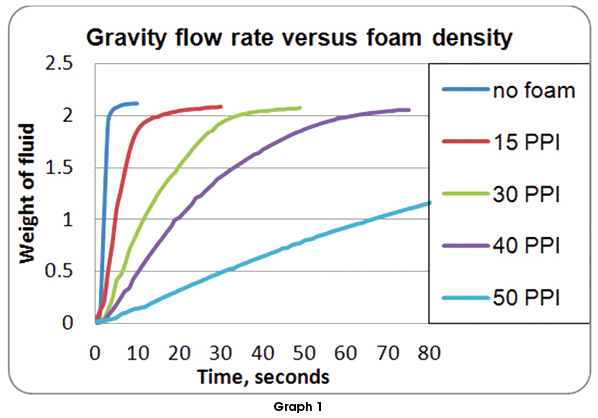
Open-cell foams with higher PPI values are used in aircraft fuel reservoirs and automotive fuel cells. PPI densities greater than 30 are common. The fluids in those applications have considerably lower viscosities and have far lower fluid exchange rates than mobile equipment reservoirs. (See Fig. 3 and Graph 1.)
Testing shows that fluid in a reservoir with reticulated open-cell foam is stable and nearly motionless during rapid deceleration.

At rest, the black porous foam can be seen above the fluid in Fig. 4. White flecks above the fluid are the reflections in the open-cell foam. Fluid at the bottom of the reservoir appears solid black in this illustration. The low fill levels in this experiment were chosen to illustrate the movement of the fluid. Greater fluid levels are damped in the same manner, but clear illustration of such damping proved difficult.
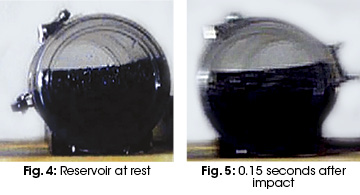 In Fig. 5, the fluid displacement is negligible when open-cell foam damps the fluid. Fig. 1 shows the response of fluid motion inside a reservoir without baffles when exposed to rapid deceleration; Fig. 5 illustrates the same reservoir with an open-cell foam damper installed. The same amount of energy was transferred during all of these experiments. The fluid with a foam baffle is considerably more stable, and slosh is eliminated.
In Fig. 5, the fluid displacement is negligible when open-cell foam damps the fluid. Fig. 1 shows the response of fluid motion inside a reservoir without baffles when exposed to rapid deceleration; Fig. 5 illustrates the same reservoir with an open-cell foam damper installed. The same amount of energy was transferred during all of these experiments. The fluid with a foam baffle is considerably more stable, and slosh is eliminated.
While fluid damping is a desirable asset, there are several other advantages from open-cell foam baffles.
Open-cell foam disperses and diffuses returning fluid to prevent short-circuit flow. Reservoirs without internal baffles allow short-circuit flow.
Open-cell foam diffuses the returning fluid stream. Without a diffuser, the return flow can adversely interact with the internal walls of the reservoir. That interaction can deliver fluid to any or all internal surfaces of the reservoir, including the breather. Additionally, a solid stream of fluid entering a reservoir can create air bubbles. Aerated fluid drawn into the suction port can cause erratic system performance or damage components.
Open-cell foam also provides cavities to capture solid contaminants similar to a filter element. When a fluid is allowed to rest in a reservoir, solid contamination precipitate out. Mobile reservoirs are often too small to allow the fluid to precipitate contaminants by gravity and do not have return filters.
When mobile fluid power reservoirs are serviced, it is common to find very small particulate contamination at the bottom of the reservoir. This is called “silt.” Non-ferrous silt cannot be removed by a magnet, but can damage hydraulic system components. Silt can be rinsed away by fast-moving fluid, returning the contamination back into suspension. Open-cell foam allows small particulates to remain at the bottom of the reservoir by dispersing the return flow. When servicing the equipment, the open-cell foam is removed and rinsed, releasing trapped contaminants before being reinstalled.
In conclusion, open-cell polymer foam baffles with low pore-per-inch values provide cost-effective fluid damping and other desirable features in mobile equipment reservoirs.
This article is based on a webinar offered by the International Fluid Power Society. For a list of upcoming webinars, visit www.ifps.org.


